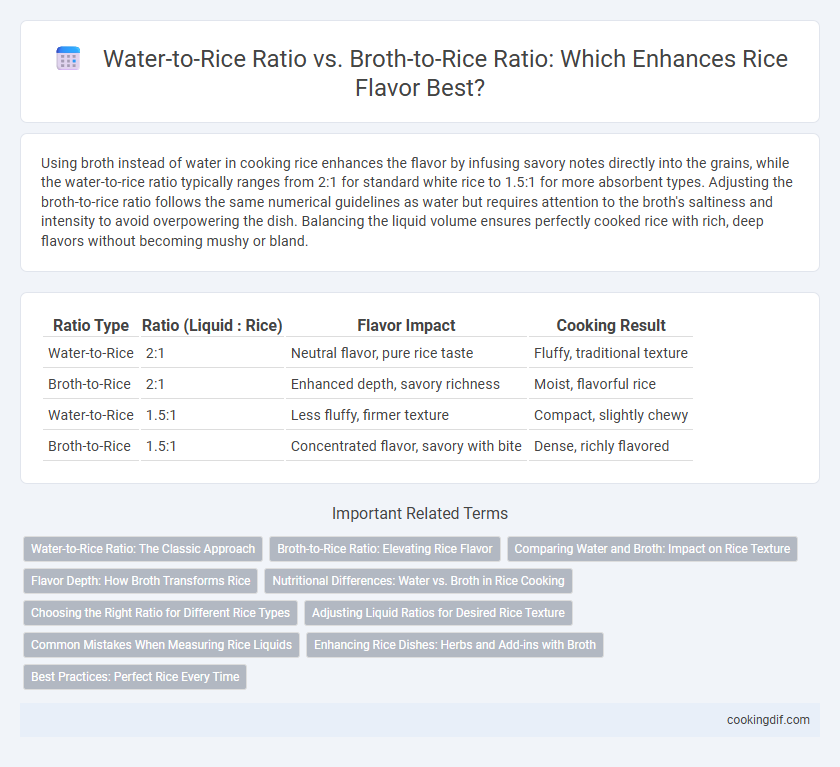Using broth instead of water in cooking rice enhances the flavor by infusing savory notes directly into the grains, while the water-to-rice ratio typically ranges from 2:1 for standard white rice to 1.5:1 for more absorbent types. Adjusting the broth-to-rice ratio follows the same numerical guidelines as water but requires attention to the broth's saltiness and intensity to avoid overpowering the dish. Balancing the liquid volume ensures perfectly cooked rice with rich, deep flavors without becoming mushy or bland.
Table of Comparison
| Ratio Type | Ratio (Liquid : Rice) | Flavor Impact | Cooking Result |
|---|---|---|---|
| Water-to-Rice | 2:1 | Neutral flavor, pure rice taste | Fluffy, traditional texture |
| Broth-to-Rice | 2:1 | Enhanced depth, savory richness | Moist, flavorful rice |
| Water-to-Rice | 1.5:1 | Less fluffy, firmer texture | Compact, slightly chewy |
| Broth-to-Rice | 1.5:1 | Concentrated flavor, savory with bite | Dense, richly flavored |
Water-to-Rice Ratio: The Classic Approach
The water-to-rice ratio is the foundational method for cooking rice, typically using 2 cups of water per 1 cup of rice to achieve the ideal texture. This classic approach ensures even absorption and prevents mushiness or dryness, making it the most reliable for fluffy, well-cooked grains. While broth-to-rice ratios enhance flavor by substituting water with seasoned stock, the water-to-rice ratio remains crucial for perfect rice consistency.
Broth-to-Rice Ratio: Elevating Rice Flavor
Using a broth-to-rice ratio of 2:1 significantly enhances the rice's flavor by allowing it to absorb rich, savory notes directly from the liquid during cooking. Unlike plain water, broth infuses the rice with depth and complexity, elevating dishes like risotto, pilaf, or jambalaya. Precision in this ratio ensures optimal moisture absorption without sogginess, balancing texture and taste for a superior culinary experience.
Comparing Water and Broth: Impact on Rice Texture
Using broth instead of water enhances rice flavor by infusing it with savory depth, while the water-to-rice ratio primarily influences texture and moisture absorption. Broth's natural salts and aromatics can slightly alter the rice's cooking time and consistency, often requiring a slightly adjusted liquid-to-rice ratio for optimal tenderness. Choosing broth typically results in a richer taste and softer texture compared to the neutral profile achieved with water.
Flavor Depth: How Broth Transforms Rice
Using broth instead of water in the cooking ratio significantly enhances flavor depth, infusing rice grains with rich, savory notes from herbs, spices, and seasonings dissolved in the liquid. A typical broth-to-rice ratio of 2:1 ensures optimal absorption, allowing rice to develop a complex taste profile that plain water cannot achieve. This transformation leverages the broth's natural umami and minerals, making each bite more flavorful and aromatic compared to traditional water-cooked rice.
Nutritional Differences: Water vs. Broth in Rice Cooking
Using broth instead of water to cook rice enhances flavor through added nutrients such as proteins, vitamins, and minerals found in broth, which water lacks. The broth-to-rice ratio generally remains similar to the water-to-rice ratio, approximately 2:1, but the broth imparts additional micronutrients and antioxidants that improve nutritional value. Choosing broth over water can increase intake of essential electrolytes, amino acids, and bioactive compounds, contributing to a more nutritious rice dish.
Choosing the Right Ratio for Different Rice Types
The water-to-rice ratio typically varies between 1.5:1 and 2:1, but using broth instead of water enhances the rice's flavor by infusing savory notes during cooking. For long-grain rice like basmati or jasmine, a 1.5:1 broth-to-rice ratio preserves texture while maximizing taste, whereas short-grain varieties benefit from a 1.75:1 ratio to maintain moisture and absorb rich flavors. Adjusting the liquid ratio based on rice type ensures optimal consistency and flavor infusion, critical for dishes ranging from pilafs to risottos.
Adjusting Liquid Ratios for Desired Rice Texture
Adjusting the water-to-rice ratio directly influences the rice's texture, with a standard 2:1 ratio yielding fluffy, well-cooked grains, while reducing water results in firmer rice. Using broth instead of water enhances flavor depth, and maintaining the correct broth-to-rice ratio ensures the rice absorbs rich seasonings without becoming mushy. Optimal liquid ratios depend on rice type and desired texture, making precise measurement essential for culinary success.
Common Mistakes When Measuring Rice Liquids
Using an incorrect water-to-rice ratio often results in undercooked or mushy rice, while substituting broth without adjusting the ratio can lead to overpowering flavors or insufficient cooking. Common mistakes include measuring liquids by volume but failing to account for broth's salt concentration and fat content, which influence texture and taste. Precise measurement and balancing of broth with water ensure optimal rice absorption and enhanced flavor without compromising consistency.
Enhancing Rice Dishes: Herbs and Add-ins with Broth
Using broth instead of water in a 2:1 liquid-to-rice ratio significantly enhances the flavor profile of rice dishes by infusing herbs and spices more effectively. Broth, rich in umami and aromatic compounds, allows herbs like thyme, rosemary, and bay leaves to release deeper flavors during cooking compared to plain water. This method creates a savory, well-rounded taste, making herbs and add-ins like sauteed garlic and onions more pronounced and integral to the rice's overall flavor.
Best Practices: Perfect Rice Every Time
Using the correct water-to-rice ratio, typically 2:1 for white rice, ensures proper texture and doneness, while broth-to-rice ratios enhance flavor by substituting water with nutrient-rich stocks. Broth concentration and salt levels impact the final taste, so using low-sodium broth allows better control over seasoning. For perfect rice every time, balance hydration needs with flavor infusion by adjusting liquid volume based on rice type and broth strength.
Water-to-rice ratio vs Broth-to-rice ratio for flavor Infographic

 cookingdif.com
cookingdif.com